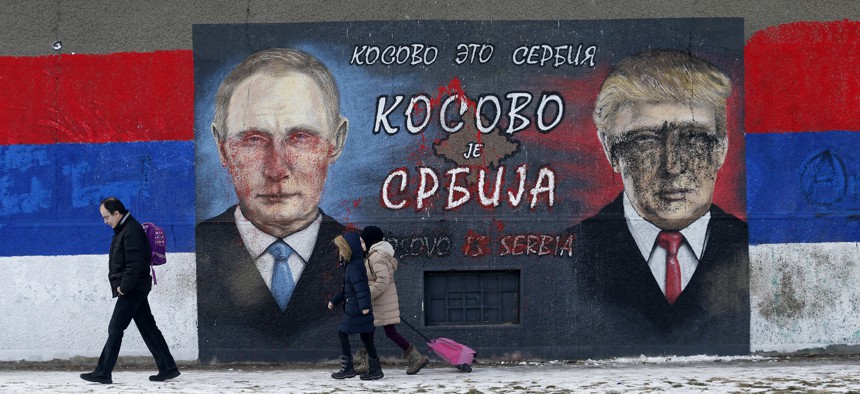
People walk by graffiti depicting the Russian President Vladimir Putin, left, and then-US President-elect Donald Trump, in Belgrade, Serbia, Jan. 20, 2017. Darko Vojinovic/AP
President Trump, Viewed through NATO’s Guide to Russian Information Warfare
Russia uses theft, narratives, lies, trolls, and bots to weaken Western governments. The U.S. president is playing into its hands.
In discussing what President Trump might do in cybersecurity, an acquaintance sent me a hyperlink to a story supporting his perspective. The link contained an article from RT, formerly known as Russia Today–a tool of the Russian government. The link appeared during our robust sharing of ideas, not as a warning about Russian propaganda. But, there, in my email inbox was a manifestation of Russian information warfare.
Lest you think me paranoid, look at the Handbook of Russian Information Warfare. Keir Giles of Chatham House wrote the Handbook for NATO personnel who have not “studied Russian principles of war fighting” but who should understand “current and projected Russian operations in the information and cyber domains.” The Handbook deserves a broader audience. By drawing on Russian and Western sources, Giles explains basic concepts, objectives, historical development, implementation, and likely future of Russian information warfare. With the 2016 election “hack and leak” campaign fading from headlines, the Handbook is a warning about an information conflict Russia is waging to obtain strategic advantage over the United States.
Particularly valuable are Giles’ efforts to demonstrate how differently Russia thinks about information warfare compared to the United States and its NATO allies. The Handbook shows that, for Russia, information communicated through all media is simultaneously a weapon, target, and operational domain in peace and war. Giles quotes a Russian expert arguing that winning “information confrontations” achieves strategic victory “in the defeat of an enemy’s armed forces[,] . . . the capture of his territory, destruction of his economic potential, and overthrow of his political system.” Here, “information” has no independent value. Facts and lies, truth and deceit are equally valuable.
Russia’s approach does not privilege cyber-enabled information, but the internet makes Moscow’s information operations “cheaper, simpler, and more permanent than in previous decades when the primary medium was newspapers.” Russia exploits the internet through “sock puppet media outlets,” troll farms and campaigns, and automated botnets in order to engage in information warfare at an unprecedented scale, speed, sophistication, and intensity.
The Handbook details how Russia integrates information warfare techniques into its political, diplomatic, and military toolkits. This integration is manifest in spheres of armed conflict (e.g., Crimea, Ukraine, and Syria) and in non-military contestation over power and influence. As Giles observes, in Russian thinking, “there are no rear areas” in information warfare. Equally worrying is the Handbook’s conclusion that Russia is constantly developing its capabilities, tactics, and targets such that “future campaigns will not resemble the ones seen to date.”
The Handbook does not develop a policy agenda for responding to Russian information warfare. However, Giles observes that “Euro-Atlantic . . . ‘post-fact’ or ‘post-truth’ political environments” mean that, for Russian information operations against the West, “much of its work has already been done.” Giles does not pursue this point, but President Trump and his administration do, indeed, unwittingly function as a troll farm and botnet for Russian information warfare.
As a candidate, president-elect, and president, Trump has attacked Congress, the judiciary, civil servants, the intelligence community, the media, American corporations, NATO, European Union, and U.S. allies. This onslaught has involved a torrent of deceit, distortion, deception, and “alternative facts” from the president and his advisors. Meanwhile, President Trump declares his respect for Vladimir Putin, seeks better relations with Russia, ignores the implications of Russian interference in the U.S. elections, and equates Russian state violence at home and abroad with U.S. behavior.
These attacks on American institutions and allies, the political falsehoods, and the pro-Russian views spread through all media channels, including those in the United States and abroad that proliferate “fake news” over the internet and provide sustenance for the divisive echo chambers of social media. Like Russian information operations, the Trump administration’s behavior damages the legitimacy of American leadership and power, sows doubt and confusion about what is actually happening, and dilutes resistance to Russian actions, interests, and influence.
This environment proves deleterious for the infrequent administration statements that take a firmer line against Russia, such as those from Nikki Haley, the U.S. ambassador to the United Nations. In particular, these statements project dissonance within the administration rather than solidarity in the White House and between the United States and its allies on a strategy for addressing the threats Russia presents.
As the Handbook emphasizes, Russian information warfare thinking anticipates that trolls and bots not under Kremlin control will amplify the messages and effects of Russia’s own information operations. However, having a U.S. president, his administration, and his own networks of disinformation playing these roles is probably beyond the wildest dreams of Russian strategists and tacticians of information warfare. Putin will not squander this opportunity.
This post appears courtesy of CFR.org.




